The ZephVR is a real virtual reality accessory for VR headsets like the Oculus Rift, HTC Vive, and PSVR, that lets you feel the action. Attaching to current-generation VR headsets, the ZephVR accessory uses machine learning to blow air on your face to simulate real wind and movement in games and experiences.
One of the biggest difficulties with virtual reality, is that as real as it looks, you don’t actually feel much. You might ‘feel’ like you’re there, but beyond a little haptic feedback through motors in your controllers, there is no touch sensitivity in games and experiences. That is perhaps most noticeable when you’re flying through the air or racing along the ground because without feeling the air on your face, there is not much indication to the reptilian part of your brain that you’re actually moving.
That is what the ZephVR add-on accessory is designed to fix. It looks a little similar to cooling systems like the Vive n’ Chill, but Zeph VR is designed to do more than just cool you down. It’s supposed to make you feel the in-game wind on your face.
The fans are said to be powerful, quick-acting and most importantly, quiet. They work by listening for the sound of ‘wind’ in games where it is apparent and blow on you in conjunction with that audible cue. The developers claim to have categorized hours of in-game audio and then used machine learning to pick out unique identifiers, so the fans should only blow when the time is right.
For games where the rush of wind isn’t apparent, they are said to still add to the experience. In the case of horror game jumps scares, a brush of wind on the face is said to massively enhance the feeling.
That all happens without any input from the user as part of the fans’ ‘autonomous’ mode. At the flick of a switch, the user can also turn it to ‘always-on’, which lets the ZephVR cool the user so they can play for longer in the confines of their VR headset.
The ZephVR is available now on Kickstarter, with at ‘Earliest bird’ pledge level of $50. That gets you the ZephVR itself, along with a 15ft mini-USB cable for Oculus Rift users. Those late to the party will need to spend $90 for an Oculus Rift or HTC Vive compatible version. PSVR users will need to spend up to $120, due to the additional need for an audio processing box and audio cable.
Whatever you opt for though, you should be netting a saving. The developers told Digital Trends that the final retail price could be as much as $150.
All versions are slated to ship out in May, though as with all Kickstarter campaigns, that is not set in stone.


Comments are closed, but trackbacks and pingbacks are open.